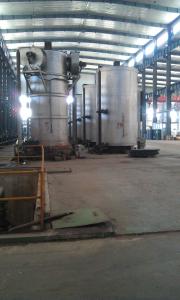High Quality of Tinplate for Chemical Cans Containers
- Loading Port:
- China Main Port
- Payment Terms:
- TT OR LC
- Min Order Qty:
- -
- Supply Capability:
- -
OKorder Service Pledge
OKorder Financial Service
You Might Also Like
Our tin plate (TP) products are made by coating tin using electrolysis on the surface of thin coldrolled steel sheet (black plates), with a thickness of 0.14~0.6 mm. Its shiny surface finish, superb corrosion resistance and formability make tin plates an ideal choice for the food industry and industrial parts producers. Our tin free steel sheet (ECCS) is widely accepted as a more economical substitute for the tin coated steel. Our TP/TFS products are widely used in the production of 3-piece and 2piece (D&I, DRD) cans as well as can lids and bottoms. Our products serve a variety of purposes, including material for steel EOE, toys, and electronic parts.
Our Tinplates Specification:
Standard: ISO 11949 -1995, GB/T2520-2000,JIS G3303,ASTM A623, BS EN 10202
Material: MR,SPCC
Thickness:0.15mm - 0.50mm
Width: 600mm -1150mm
Temper: T1-T5
Annealing: BA & CA
Coil Inner Diameter: 508mm
Weight: 6-10 tons/coil 1~1.7 tons/sheets bundle
Passivation:311
Oil: DOS
Surface: Finish,bright,stone,matte,silver
Packing:
1、For sheets: plastic or waterproof paper, metallic cover and angles, steel strips,wooden pallet.
2、For Coils: plastic or waterproof paper,plastic protect plate,steel strips.
Both Prime and Second Quality Are Available!!!
- Q: Can tinplate be used for packaging tobacco products?
- Yes, tinplate can be used for packaging tobacco products. Tinplate is a commonly used material for packaging due to its durability, ability to preserve the freshness of the contents, and its resistance to corrosion. It is a popular choice for packaging tobacco products as it helps to maintain the flavor and quality of the tobacco.
- Q: What are the main regulations governing tinplate production?
- The main regulations governing tinplate production vary by country and region. However, some key regulations typically include guidelines on the use of materials, such as the type and thickness of tin coatings, as well as regulations on production processes to ensure safety and quality standards are met. These regulations may also cover areas such as labeling, packaging, and transportation requirements to ensure proper handling and traceability of tinplate products.
- Q: How does tinplate perform in terms of gas barrier properties?
- Tinplate performs fairly well in terms of gas barrier properties. It provides a good barrier against oxygen and moisture, helping to preserve the quality and freshness of packaged goods. However, it may not be as effective as some other packaging materials, such as aluminum, in preventing the permeation of certain gases.
- Q: What printing methods are used on tinplate?
- The common printing methods used on tinplate include lithography, offset printing, and silk screen printing.
- Q: What are the properties of tinplate?
- Tinplate is a type of steel that is coated with a thin layer of tin, which imparts several key properties. It is highly corrosion-resistant, making it suitable for packaging food and beverages. Tinplate also has excellent heat resistance, making it ideal for products that need to withstand high temperatures during processing or cooking. Additionally, it has good formability, allowing it to be easily shaped and molded into various sizes and designs.
- Q: What is the difference between tinplate and tin-free steel?
- Tinplate is a type of steel coated with a thin layer of tin, which provides corrosion resistance and enhances its appearance. On the other hand, tin-free steel refers to steel that does not have a tin coating, making it more cost-effective but also less resistant to corrosion.
- Q: Are there any health concerns associated with tinplate?
- Yes, there are some health concerns associated with tinplate. Tinplate can potentially leach small amounts of tin into the food or beverage stored in it, especially if it comes into contact with acidic or high-salt content products. While tin is considered relatively safe, excessive consumption of tin can lead to gastrointestinal issues and long-term exposure may have adverse effects on health. It is recommended to limit the use of tinplate for storing or consuming highly acidic or salty foods.
- Q: What is the purpose of tin coating on tinplate?
- The purpose of tin coating on tinplate is to provide a protective barrier against corrosion, as tin is highly resistant to oxidation. Additionally, the tin coating enhances the appearance of the tinplate and allows for easy soldering, making it suitable for various applications such as food packaging and decorative items.
- Q: How does tinplate packaging contribute to product reusability?
- Tinplate packaging contributes to product reusability by providing a durable and long-lasting material that can be easily reused for various purposes. Its strong resistance to corrosion and high durability make tinplate packaging suitable for multiple uses, such as storing food, beverages, or other products. Additionally, the ability to seal and reseal tinplate packaging ensures the preservation and freshness of the contents, enabling consumers to reuse the packaging for future storage needs. This reduces waste and promotes sustainability by minimizing the need for single-use packaging materials.
- Q: Can tinplate be used for packaging products with specific storage requirements?
- Yes, tinplate can be used for packaging products with specific storage requirements. Tinplate is known for its excellent durability, corrosion resistance, and ability to maintain product freshness and quality over time. It can provide an effective barrier against moisture, light, and oxygen, making it suitable for packaging products that require protection from these elements, such as food, beverages, cosmetics, and pharmaceuticals. Additionally, tinplate can be customized with various coatings and linings to meet specific storage requirements, ensuring the long-term preservation and safety of the packaged products.
Send your message to us
High Quality of Tinplate for Chemical Cans Containers
- Loading Port:
- China Main Port
- Payment Terms:
- TT OR LC
- Min Order Qty:
- -
- Supply Capability:
- -
OKorder Service Pledge
OKorder Financial Service
Similar products
Hot products
Hot Searches
Related keywords




























